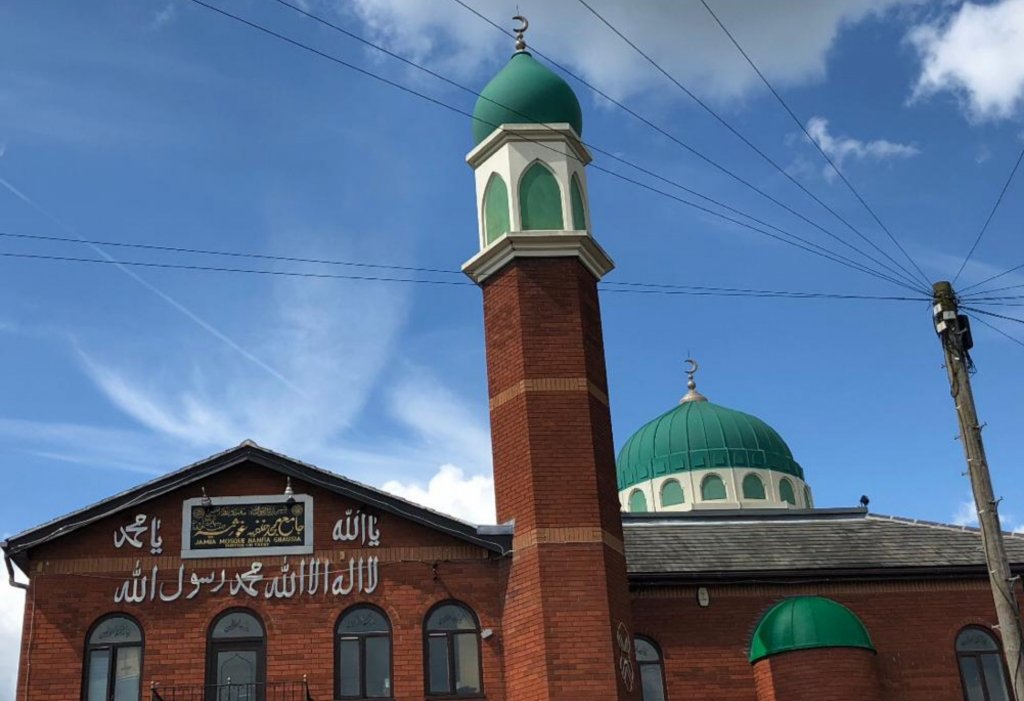About

The first mosque for the town’s Muslim community, which is predominantly Sunni, was opened in 1975 in a converted house in Byrkley Street. It was replaced in 1977 by a mosque in Princess Street, the fifth purpose built mosque in the country. That was, in turn, replaced in 2000 by the present Jamia Hanfia Ghousia mosque, built on the same site in a traditional style with minaret and dome.
The Masjid has been primarily established as a place of prayer for all Muslims with no association to any particular ethnicity or background. As a result, the attending congregations have represented the true diversity of the Muslim community making Princess Street Mosque a tremendously inclusive and welcoming place.
The Masjid is the center of the Muslim community and plays a vital role in helping them to fulfill their religious obligations. However, Princess Street Mosque aims to exceed the minimum requirements and provide a variety of services and activities that promote goodness in all its forms.
Princess Street Mosque is a non-profit organisation registered with the Charity Commission ( www.charity-commission.gov.uk) registration number: 1079117.
Etiquettes of Visiting a Masjid
Muslims would usually be delighted to show others their place of worship. It is the sharing of what they hold very dear to their heart. It is hoped, however, that the visitors observe certain basic rules of conduct.
The term Mosque is commonly used by non-Muslims to define the Muslim place of worship but its correct name is Masjid and this is the term used by Muslims. It would be preferable for non-Muslims to adapt to this correct terminology.
Before going to visit a Masjid, it is important that visitors give some thought to how they feel. The Muslims being visited would not want visitors to feel unease. Likewise, they would not want to be made ill at ease themselves by criticisms of their way of worship or of their religion. Questions are always welcomed but negative comparisons with the visitor’s own customs are unlikely to promote a friendly relationship.
Whether visiting alone or as a group, it is important to follow the guidelines for clothing and behaviour so as not to cause offence. For groups, it is important not to talk loudly, thus disturbing anyone who may be at prayer. If any group members have special needs, let the place being visited know in advance so that they can prepare to help. For example, although the custom of the Masjid is to sit on the floor, chairs can often be provided for elderly, infirm or disabled visitors.
Clothing in a Masjid
Clothing should be modest for both men and women. For women, this means an ankle-length skirt or trousers, which should not be tight or transparent, together with a long-sleeved and high-necked top. A headscarf is usually essential for women. Shoes are removed before going into the prayer hall and put on the racks provided. Clean and presentable socks, stockings, or tights are therefore a good idea.
Entering a Masjid
Where women attend the Masjid, men and women usually enter the prayer hall by separate entrances. Vistors may be greeted by the Arabic greeting “Assalam o Allaikum” which means “peace be upon you.” The answer, if the visitor would like to use it, is “Wa ‘alaikum-as-salam”, which means “peace be upon you too”. Do not offer, or expect, to shake hands with people of the opposite sex. Before entering the prayer hall or prayer room, Muslim men and women perform wudhu or ablutions if they have not already done so earlier or from home. This is not necessary for the non-Muslim visitor who will not be joining in the prayer.
Entering a Masjid Prayer Hall
Go quietly into the hall, and sit on the floor, avoiding pointing the feet in the direction of the Qibla (the wall with the niche or alcove in it, indicating the direction of Makkah), unless a medical condition makes this the only possible posture. If visiting as a group during a time when prayers are taking place, sit together toward the rear of the hall.
Worship in a Masjid
When salat (Arabic) or namaz (Persian/Urdu), one of the five daily prayer is in progress, non-Muslim visitors are welcomed but simply to observe rather than to join in. If arriving at such a time, find a place near the rear wall and sit quietly observing the prayer. No sacred or blessed food will be offered, nor will visitors be expected to make any physical gesture of respect to holy objects (except removing their shoes and acting respectfully in the prayer hall).


